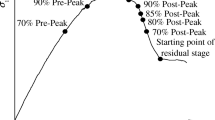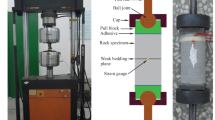Abstract
The tensile behavior of Serena sandstone is investigated by means of uni-axial tensile and bending tests. In order to obtain an overall characterisation of a quasi-brittle material, such as Serena sandstone, it is necessary to investigate the post-peak softening branch by adopting a stable control system. Test results on different size specimens are presented. Also analysed in this paper is the effect of the boundary conditions in a uni-axial tensile test by comparing free and fixed platens tests. A laser interferometry technique (ESPI) was adopted to investigate the strain field and crack propagation in the material.
A notable outcome of the research is the location of crack penetration before the peak load, that in the case of the bending test is almost constant in specimens of different size.
Résumé
Le comportement en traction du Grès de Serena est étudié ici au moyen d'essais de traction et de flexion mono-dimensionnels. Da façon à caractériser de manière générale un matériau quasifragile, tel que le grès de Serena, il est nécessaire d'étudier le domaine “plastique”, après le point de charge maximale en adoptant un système de pilotage stable. Les résultats des essais effectués sur des échantillons de taille différente sont présentés. Le présent article documente également l'effet des conditions aux limites dans un essai de traction pure, en comparant des essais avec platines libre et fixe. Une technique d'interférométrie LASER (ESPI) a été adoptée pour étudier le champ de contraintes et la propagation des fissures dans le matériau. Un résultat remarquable de cette recherche est la mise en évidence d'une amorce de fissure avant l'application de la charge maximale, que l'on peut constamment observer sur des échantillons de taille différente, lors des essais de flexion.
Similar content being viewed by others
Abbreviations
- σN t :
-
nominal stress in uni-axial tensile test
- σN b :
-
nominal stress in four-point bending test
References
Goodman, R.E., ‘Introduction to rock mechanics’, (John Wiley and Sons, New York, 1989).
Biolzi, L. and Labuz, J.F., ‘Size effects in fracture of quasi-brittle materials’, in ‘Non linear fracture and damage’, (WIT press, London, 2001) 201–243.
Cedolin, L., Dei Poli, S. and Iori, I., ‘Tensile behavior of concrete,’J. Eng. Mech ASCE 113 (3) (1987) 431–449.
Labuz, J.F. and Biolzi, L., ‘Characteristic strength of quasi-brittle materials’,Int J. Solids and Struct 35 (31–32) (1998) 4191–4203.
Cattaneo, S. and Rosati, G.P., ‘Effect of different boundary conditions in direct tensile tests: Experimental results’,Mag. of Conc. Res. 51 (5) (1999) 365–374.
Vervuurt, A., Schlangen, E. and van Mier, J.G.M., ‘Tensile cracking in concrete and sandstone: Part 2—Effect of boundary rotation’,Mater. and Struct. 29 (188) (1996) 87–96.
Binda, L., Facchini, M., Mirabella Roberti, G. and Tiraboschi, C., ‘Electronic speckle interferometry in masonty testing’,Const. and Build. Mat. 12 (5) (1998) 269–281.
Calvetti, F., Cardani, G. and Meda, A., ‘Mechanical characterization of natural building stones: observation on the fracture process zone by ESPI’ in ‘The EOS/SPIE International Symposia on Industrial Lasers and Inspection’, Munich (June 1999) 64–71.
Heilmann, H.G., Hilsdorf, H. and Finsterwalder, K., ‘Strength and deformation of concrete subjected to uniaxial tension’,Deutscher Ausschuss für Stahlbeton, Heft 203, Berlin (1969) (In German).
Rosati, G., ‘Tensile residual strength of cracked concrete and its implications in bond problems’, Ph.D. Thesis, Politecnico di Milano (1989) (In Italian).
Cardani, G. and Meda, A., ‘Flexural strength and notch sensitivity in natural building stones: Carrara marble and Dionysos marble’,Const. and Build. Mar. 13 (7) (1999) 393–403.
van Mier, J.G.M., ‘Fracture processes of concrete’, (CRC Press, Boca Raton Florida, 1997).
Bažant, Z.P., ‘Sealing laws in mechanics of failute’,J Eng Mech ASCE 119 (9) (1993) 1828–1844.
van Mier, J.G.M., ‘Fracture of concrete: the interaction between modelling and experimentation’, in International Conference on ‘Concrete under Severe Conditions’ (CONSEC '01), Vancouver, June 2001, 1626–1639.
Author information
Authors and Affiliations
Rights and permissions
About this article
Cite this article
Meda, A. Tensile behaviour in natural building stone: Serena sandstone. Mat. Struct. 36, 553–559 (2003). https://doi.org/10.1007/BF02480833
Received:
Accepted:
Issue Date:
DOI: https://doi.org/10.1007/BF02480833




